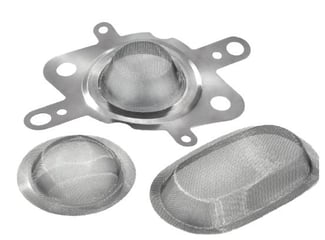Understanding the Fundamental Types of Filtration
Have you ever used a french press to make the perfect cup of coffee in the morning? If not, it involves seeping coffee grounds in hot water then separating the grounds from the water, leaving you with the secret formula needed to get through the morning.
We use this example to help illustrate that there are various forms of filtration that affect our lives daily. But knowing that all practices, methods, and techniques come from a central concept, what are the fundamental types of filtration?
W.S. Tyler has been a prominent woven wire mesh manufacturer for over 140 years of experience, helping engineers implement woven wire mesh filter cloth solutions along the way. That said, we have a team of filtration experts dedicated to helping you understand everything you need to know about the influence woven wire mesh has on the various types of filtration.
That's why this article is all about the fundamental filtration techniques used today and how woven wire mesh can benefit them. To best elaborate these points, we will be covering:
- What filtration is
- What a woven wire mesh filter is
- The fundamental types of filtration
- Why you should consider woven wire mesh
What Is Filtration?
Filtration is best defined as the process in which specific particles are screened and removed from a substance or other particles. The separation is carried out using some sort of filter media, such as woven wire mesh or perforated plate.
What Is a Woven Wire Mesh Filter?

Woven wire mesh filters are a series of individual metallic wires woven together to form various weave patterns that feature precise pore openings. Because these filters start as individual wires, parameters such as wire diameter, opening (aperture) size, micron rating, weave pattern, width, and length can be customized.
Types of Filtration Techniques
There are many forms of filtration used across dozens of industries, such as plastic extrusion and nutsche filtration. That said, all filtration operations can be traced back to one of three core types of filtration techniques:
- Straining
- Cake filtration
- Depth filtration
Straining
Straining is the filtration process commonly perceived as the root definition of filtration. It involves catching and separating particles using a sieving effect.
In other words, particles larger than the filter mesh openings will be stopped with the smaller particles passing through.
Cake Filtration
Cake filtration is the filtration technique in which a high number of particles are trapped by the filter medium to form a particle bed referred to as a filter cake. That said, once this filter cake is created, it becomes the primary filter medium.
This means that the filter cake will begin catching particles that are smaller than the original filter medium. This also means that resistance to flow comes from both the filter medium and the cake.
So, as the cake grows thicker, the resistance becomes higher.
Depth Filtration
With depth filtration, the filter media is thick, and the particles traveling through the filter are get caught on their way thru the filter. During the depth filtration process, particles can be removed by:
- Transport mechanisms (how the particle travels through the filter)
- Straining
- Interception
- Inertia
- Sedimentation
- Diffusion
- Adhesion
- Electrostatic force
Now, most particles in Depth Filtration will be collected by the "web" formed by previously captured particles. Initially, the filter efficiency increases with time due to this dendrite formation; however, extended filtration brings the particles to a breakthrough point, and the filtration efficiency starts to decrease.
NOTE: Depth filters cannot be cleaned using backflushing techniques.
Why Use Woven Wire Mesh?
When compared to other filter media, woven wire mesh features several benefits that help it stand out. This includes its ability to deliver optimal flow rate, accuracy, and durability.
Flow Rate
As the wire diameter and mesh openings can be fine-tuned to accommodate your needs, woven wire mesh is proven to deliver a better flow rate than other materials. This becomes more apparent when three-dimensional weave patterns, such as W.S Tyler's RPD HIFLO-S, are used.
Using a three-dimensional takes two layers of filter cloth, stacks them, and offsets them. This, in turn, doubles the amount of pore openings in the same filtration surface area.
Accuracy
The weaving process used to construct woven wire filters has been refined over several decades and is conducted under stringent guidelines. This helps ensure the pore openings of woven wire filter cloth are rigid and exact.
Having a filter cloth with exact pore openings ensures a consistent filtration process that produces results that comply with industry standards.
Durability
Woven wire mesh filters are commonly woven using a 300 series stainless steel, whether 304 or 316 stainless steel. As a result, woven wire mesh has the ability to hold up even when subjected to various impurities, pressure, and temperatures.
While the ability to be formed to fit most filtration systems, the durable qualities of woven wire mesh allow it to preserve its shape after dozens of uses.
Gain a Comprehensive Understanding of Woven Wire Mesh Filter Cloth
Filtration is the process in which a filter medium, such as a woven wire mesh, is used to separate particles from a substance. While each manufacturer that relies on filtration runs its operation differently, filtration, at its core, can be traced back to three fundamental techniques.
These techniques are straining, cake filtration, depth filtration.
Now, incorporating woven wire mesh filters can be a big investment. To truly understand whether or not woven wire mesh is the right filter medium for you, it's critical to gain a complete understanding of what wire mesh has to offer.
Having helped engineers navigate the world of woven wire mesh for over 140 years, W.S. Tyler is determined to guide you towards the ideal mesh solutions.
This is why we created a wire mesh filter ultimate guide to serve as your one-stop-shop for everything you need to confidently determine if woven wire mesh is suitable for your needs. The guide can be accessed below:




